This is the first of a two-part series on techniques for measuring adhesion and abrasion durability of coatings and inks. This first issue will examine adhesion. Part two will address abrasion durability, including new equipment and measurement techniques.
Adhesion and abrasion durability of cured coatings and inks are two critical performance properties, and their measurement and control are essential for robust manufacturing. Adhesion and abrasion durability are discrete physical properties and commonly misdiagnosed during failure mode analysis. Poor adhesion and abrasion durability are leading causes of field failures, scrap and rework, lower profits, and dissatisfied customers. Techniques exist to measure these properties. This article addresses several different test methods and instruments. Among these is a new linear abraser made by Taber Industries that is designed to evaluate actual product shapes involving contoured surfaces as well as flat specimens (part two). Advanced measurement techniques such as the ones cited in this paper are helping manufacturers achieve superior product performance and six-sigma process excellence.
Adhesion versus Abrasion
Optimal adhesion and abrasion durability (resistance) of cured coatings and inks onto plastic substrates must be achieved during manufacturing to produce high quality products that will endure throughout their service life. These properties can be interdepen- dent but often are mutually exclusive. That is, cured coatings and inks can demonstrate good adhesion and poor abrasion, or poor adhesion and good abrasion. Proper testing and understanding of adhesion and abrasion ensures conformance to specifications and is invaluable in solving coating and printing problems. The identification of the failure mechanism, adhesion (cohesion), abrasion or both, will determine the engineering process solution. Historical test methods and new instrumentation exist to measure and analyze these properties.
Adhesion Test Methods
ASTM D 3359 Standard Test Method for Measuring Adhesion by Tape Test is historically perhaps the most well-known and widely used method for testing adhesion of coatings and inks because of its simplicity and low cost. The most basic procedure for conducting the tape test includes the following:
- Agreement on the selection of tape.
- Complete cure of the coatings and inks before testing.
- Making “X”-cuts in the film per Method A or lattice pattern with either six or eleven cuts in each direction per Method B.
- Removing and discarding two laps of tape from the roll dispenser.
- Smoothing the tape into place by finger and then rubbing firmly with an eraser on the end of a pencil, or similar (the color under the tape being a good indicator of complete contact).
- Within 60-120 seconds of application, removing the tape by pulling the free end rapidly (not jerked) back upon itself as close to an angle of 180 degrees as possible.
- Inspecting the cut area for removal of coating from the substrate and rating the adhesion relative to pre-determined descriptions and illustrations classifications (0B, 1B, 2B, 3B, 4B, 5B).
Early versions of ASTM D 3359 referenced the use of 3M 710 and Permacel tape. 3M discontinued its product, and over the years, Permacel changed the properties of its tape. The ASTM subcommittee advised users to check whether the current Permacel gives comparable results to the original tape. This proved to be impractical and opened the floodgates for companies to use virtually any type of pressure-sensitive tape. Many companies today use abbreviated versions of ASTM D 3359, in which specific product niches are tested as similarly as possible, e.g., cellular phones, computer keyboards, automotive components, etc. Several commonly used techniques and pressure-sensitive tapes are shown.
There are important considerations to keep in mind when conducting the tape test so that repeatable and reproducible results can be achieved to determine acceptable or unacceptable adhesion without bias. Batches (rolls) of tape as manufactured have inherent adhesion variability, especially over time. For example, independent laboratories have noted differences of up to 50 percent. The tape test is qualitative and cannot precisely assess quantitatively the actual strength of the adhesive bond (only a minimum value was met). However, it does provide relative adhesion performance. The test method was originally developed for ductile coatings applied to metal substrates and not for coatings or inks applied to plastic products.
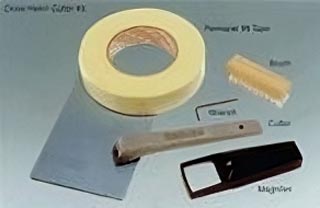
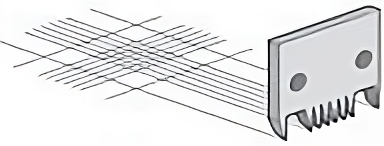
| Tape | Resin | Adhesion to Steel | Manufacturer |
|---|---|---|---|
| Scotch 600 Transparent | Acrylic | 25 oz/in | 3M |
| Scotch 610 Cellophane | Rubber | 43 oz/in | 3M |
| Scotch 810 Magic Tape | Acrylic | 25 oz/in | 3M |
| Lithographers 616 Tape | Rubber | 36 oz/in | 3M |
| Scotch 893 Filament Tape | Rubber | 55 oz/in | 3M |
| Permacel 99 | Rubber | 52 oz/in | Nitto Denko |
The cross-cut test is a simple and easily predictable method for evaluating the adhesion of single- or multi-coat systems.
Procedure
- Make a lattice pattern in the film with the appropriate tool, cutting to the substrate
- Brush in diagonal direction 5 times each, using a brush pen or tape over the cut and remove with Permacel tape
- Examine the grid area using an illuminated magnifier
Cross-Cut Results
Adhesion is rated in accordance with the scale below:
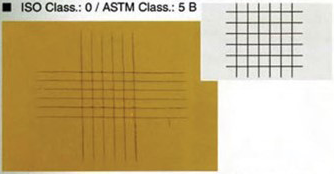
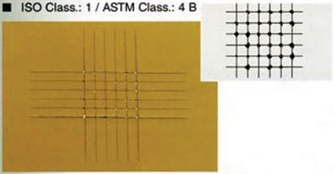
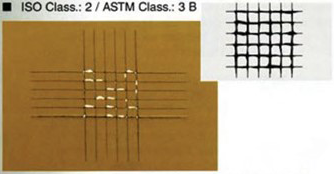
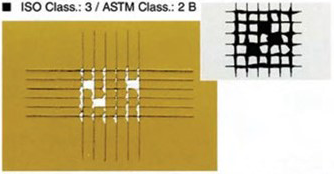
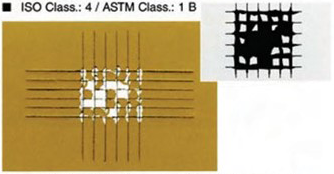

| Standards | ||
|---|---|---|
| ASTM | D 3002 | D 3359 |
| DIN EN | ISO | 2409 |
*DIN 53151 was withdrawn in October 1994
Thus, when a flexible adhesive tape is applied to a flexible or semi-rigid plastic, rather than a rigid metal, the peel phenomenon and failure mechanisms are different
Differences in tapes, backing stiffness, and adhesive theology can yield different results even on the same product tested. A given tape formulation inherently does not adhere equally to all coatings and plastics. Surface texture is also an important factor. ASTM D 3359, by design, was made to be simple and not require calibrated equipment. Thus, the test accuracy is operator dependent.
ASTM D 4541 Standard Test Method for Pull-Off Strength of Coatings Using Portable Adhesion Testers is also a well-known standard. Unlike ASTM D 3359, however, it requires the use of instrument apparatus referred to as pull-off adhesion testers. Several different instrument apparatus models are cited (fixed alignment, hydraulic, pneumatic) and may yield different results depending upon the instrument parameters and usage. The tensile adhesion test determines either the greatest perpendicular force (in tension) that a surface area can bear before any material is detached or whether the surface remains intact at a predetermined force (pass/fail). Results from extensive industry test- ing with the three models on identical surfaces vary considerably, making direct comparison impractical.
Regardless of which pull-off adhesion tester is used, the procedure begins with securing a loading fixture (termed “Dolly”) perpendicular to the surface of the coating with an adhesive. After the adhesive is cured, a testing apparatus is attached to the loading fixture and aligned to apply tension normal to the test surface. The force applied to the loading fixture is gradually increased until either material detachment “pull-off” occurs or the specified value is achieved.
When multiple coatings are applied, the nature of the failure mechanism, adhesive or cohesive failure, will be derived. Two examples of the many devices commercially available are shown below. Figures A and B show the Elcometer 106 Fixed Alignment apparatus and figures C and D show the Defelsko Hydraulic Self-Aligning apparatus.

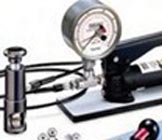


For any of the pull-off adhesion testers, surface preparation of the dolly and application of adhesive is important to achieving accurate, reproducible results. Many dollies, as purchased, have smooth machined and/or end milled surfaces, however they typi- cally yield weaker bonds. Some users of pull-off adhesion testers may modify the dolly surface using either Scotch-Brite® pad or sandpaper to provide a slightly roughened surface, creating microstructures for maximum bond strength. After “dressing” the dolly, it must be cleaned (usually alcohol and dry cloth) to remove excess grit, oils, and oxidation. A common adhesive used is Araldite 2011, a two-component epoxy that may require up to 24 hours to cure before the pull test can be conducted. Other adhesives can be selected, but it is paramount that the adhesive not affect or interact with the coating, or the test results will be of minimal value.
Regardless of the pull-off adhesion tester selected for use, the most critical aspect of conducting this test is the consistency of how the test is conducted. Even slight variations in procedure will cause statistically significant data results. Many users of this test method use disposable aluminum dollies. Documented procedures will help minimize variation as a result of inconsistent setup.
ASTM D 4541 was also developed for the specific purpose of testing coatings on rigid structures such as metal, concrete, or wood. Unlike ASTM D 3351, that can be conducted on relatively small parts, ASTM D 4541 typically requires product sizes of three inches or larger to accommodate standard dolly sizes (although custom dollies can be purchased). ASTM D 4541 procedure should be conducted in at least 2-3 locations on a part, which can make it impractical for small products. The decision to use ASTM D 3351, ASTM D 4541, or other adhesion tests is up to each company and may be influenced by historical testing conducted within its market niche.
Test Standards and Process Excellence
Many companies use some of the test methods discussed in this paper out of necessity, i.e., to acquire business by demonstrating their manufacturing processes conform to specific industry standards. Unfortunately, manufacturers can often be unaware of field failure problems until their customers return nonconforming products. By default, “poor adhesion” is to blame. Through proper understanding of the many possible causes for adhesion versus abrasion failures, engineers can adroitly identify the critical root causes and implement corrective actions. Testing should not be reserved only for product development and troubleshooting. Continuous in-line testing of products using the methods and techniques presented and Six Sigma techniques will ensure robust manufacturing.
Acknowledgements
3M Corporation Industrial Tape & Specialties
Division American Society of Testing and Materials International
BYK Gardner
Defelsko Corporation
Elcometer Inc
Gardner Company
Permacel (Nitto Denko Company)
Scott R. Sabreen is founder & president of The Sabreen Group, Inc. (TSG). TSG is a global engineering company specializing in secondary plastics manufacturing processes – surface pretreatments, bonding, decorating & finishing, laser marking, and product security. For more information, call toll-free (888) SABREEN or visit: www.sabreen.com.



